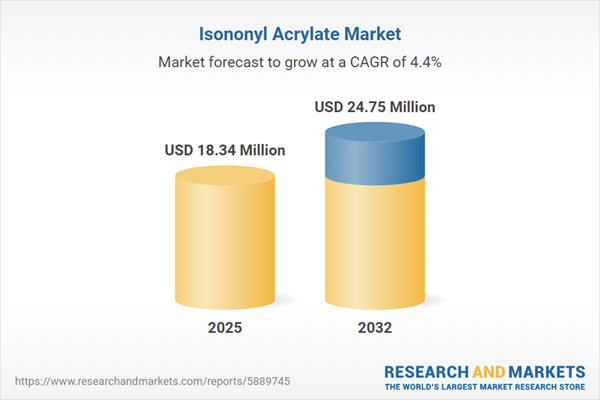Speak directly to the analyst to clarify any post sales queries you may have.
The isononyl acrylate market is undergoing notable transformation as senior leaders navigate a complex environment shaped by changing procurement demands, emerging technologies, and tightening regulatory standards. Informed strategy is pivotal for sustaining growth and maintaining a competitive edge in this specialized chemical sector.
Isononyl Acrylate Market Snapshot
Current market analysis highlights a stable upward trajectory for isononyl acrylate, driven by specialized applications in adhesives and coatings. Global market size is expected to rise from USD 17.59 million in 2024 to USD 18.34 million in 2025 and reach USD 24.75 million by 2032, equating to a compound annual growth rate (CAGR) of 4.36%. Contributing factors include accelerated adoption in specialty adhesives and advanced coatings, with research investments and operational enhancements fueling sector innovation. Evolving regulations and heightened customer criteria are prompting companies to revisit procurement methodologies and strengthen their approach to differentiation.
Isononyl Acrylate Market Scope & Segmentation
Clarity on the scope and structure of the isononyl acrylate market enables senior executives to optimize strategies, improve resource deployment, and adapt to rapidly altering customer and industry trends.
- Applications: Supports the development of flexible adhesives, sealants, robust industrial and architectural coatings, and offers increased efficiency and aesthetics in leather and textile finishing.
- End Use Industries: Applied across automotive, construction, infrastructure, electronics, packaging, and textile fields where product reliability and performance are essential.
- Product Forms: Available in water-based, solvent-based, solvent-free, and dry powder types to suit varying manufacturing and application processes.
- Functional Roles: Functions as a polymer additive with customizable properties, enhances process rheology, enables fast UV-curing, and acts as a photoinitiator in demanding technical settings.
- Regional Markets: Deployed in North America, South America, Europe, Asia-Pacific, the Middle East, and Africa, each market managing region-specific standards and priorities influencing supplier engagement and strategy.
- Leading Companies: Key providers such as BASF SE, Allnex Belgium SA, Arkema SA, Covestro AG, DIC Corporation, Lubrizol Corporation, Mitsubishi Chemical Holdings, and Sartomer Company deliver innovative and region-adapted market solutions.
Isononyl Acrylate: Key Takeaways for Senior Decision-Makers
- Significant progress in polymer technology has improved production reliability, which aids organizations in achieving both performance and sustainability milestones.
- Growing environmental expectations are motivating the shift to bio-based and lower emission products, placing strategic importance on agile supply chain management.
- Procurement teams are increasingly collaborating with suppliers and clients to co-create tailored solutions aligned with new operational and business requirements.
- Enterprises are expanding supplier portfolios and adopting flexible management methods to better address potential regulatory and external disruptions.
- Advancements in digital integrations—such as process automation and real-time monitoring—are enhancing quality oversight and supporting regulatory compliance.
Tariff Impact on Specialty Chemical Supply Chains
Recent tariffs in the United States affecting specialty chemicals require organizations to reevaluate supplier networks and realign procurement strategies. Expanding supplier partnerships and restructuring frameworks allow businesses to remain cost-conscious while mitigating risks and meeting compliance obligations under shifting trade regulations.
Methodology & Data Sources
The findings are based on executive-level interviews, industry literature reviews, and in-depth regulatory assessments. Scenario modeling and data triangulation validate all insights, helping procurement and supply chain leaders drive effective decisions.
Why This Report Matters
- Gives senior executives actionable intelligence to proactively manage regulatory and procurement risks across diverse and evolving markets.
- Outlines strategic approaches to strengthen supply chain adaptability and support compliance on both global and local scales.
- Highlights pathways for targeted investments and operational improvement, aligning with sustainable business practices and dynamic customer requirements.
Conclusion
Market insights enable senior leaders to elevate procurement strategies and stimulate innovation, equipping organizations with tools to build enduring competitiveness within the specialty chemicals sector.
Additional Product Information:
- Purchase of this report includes 1 year online access with quarterly updates.
- This report can be updated on request. Please contact our Customer Experience team using the Ask a Question widget on our website.
Table of Contents
3. Executive Summary
4. Market Overview
7. Cumulative Impact of Artificial Intelligence 2025
Companies Mentioned
The companies profiled in this Isononyl Acrylate market report include:- BASF SE
- Allnex Belgium SA
- Arkema SA
- Covestro AG
- DIC Corporation
- The Lubrizol Corporation
- Mitsubishi Chemical Holdings Corporation
- Sartomer Company, Inc.
Table Information
| Report Attribute | Details |
|---|---|
| No. of Pages | 192 |
| Published | November 2025 |
| Forecast Period | 2025 - 2032 |
| Estimated Market Value ( USD | $ 18.34 Million |
| Forecasted Market Value ( USD | $ 24.75 Million |
| Compound Annual Growth Rate | 4.3% |
| Regions Covered | Global |
| No. of Companies Mentioned | 9 |









